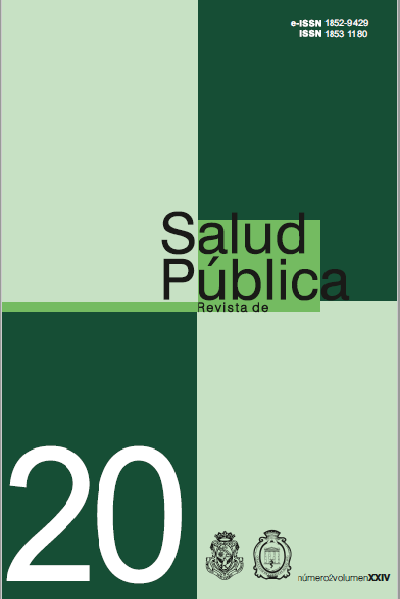Urbanization and food environment related to cardiovascular health in La Calera city, Córdoba, Argentina, 2016-2017
DOI:
https://doi.org/10.31052/1853.1180.v24.n2.28515Keywords:
cardiovascular diseases, urbanization, foodAbstract
Objective: analyze the food environment through the commercial availability of food associated with cardiovascular health and its relationship with the level of urbanization in the city of La Calera.
Methodology: the characteristics of urbanization and commercial availability of food were relieved. The association between urbanization characteristics and food availability by area was analyzed. The food commercial environment was georefenced with the QGIS 2.18.4 program - Las Palmas.
Results: the geographical areas were categorized as: Urbanization level 1 (reached or exceeded 75% of the urbanization indicators studied, central, northern and western areas) and Urbanization level 2 (did not reach 75% of the indicators, southern and eastern areas). The availability of margarine (p=0.04) and packaged bread (p=0.01) was higher in areas with lower levels of urbanization.
Conclusions: urbanization indicators significantly affected the commercial availability of margarine and packaged breads.
Downloads
References
nutrition surveillance: the CDC experience. J Nutr. 1990; 120 Suppl 11:1512-8.
2. Uauy R, Albala C, Kain J. Obesity Trends in Latin America: Transiting from Under-To Overweight. Journal Nutr 2001; 131:893S-9S.
3. NCD Alliance, 2011. Non-communicable diseases: A Priority for Women’s Health and development. [pdf] Geneva: The NCD Alliance. [Consultado: noviembre de 2018]. Disponible en: http://www.who.int/pmnch/topics/maternal/2011_women_ncd_report.pdf.pdf.
4. Balaguer VI. Control y prevención de las enfermedades cardiovasculares en el mundo. Rev Esp Cardiol. 2004; 57:487-94.
5. Giugliano D, Esposito K. Mediterranean diet and metabolic diseases. Current Opinion in Lipidology. 2008; 19:63-8 10.
6. Colautti, F. La Calera, la que más creció en 10 años. La Voz del Interior. Córdoba, Argentina: 2013. [Consultado: noviembre de 2014]. Disponible en: http://www.lavoz.com.ar/cordoba/calera-que-mas-crecio-10-anos.
7. Caron P, Kalafatic C, Allahoury A. La nutrición y los sistemas alimentarios. Roma: FAO; 2018. Disponible en: http://www.fao.org/3/I7846ES/i7846es.pdf
8. Food and Agriculture Organization (FAO). Influir en los entornos alimentarios en pro de dietas saludables. 2016. Disponible en: http://www.fao.org/3/a-i6491s.pdf
9. Coral CBS, Carmen GC, Consuelo LN, Bricia LP. Manual de alimentación. Planificación alimentaria. Madrid: Editorial UNED; 2016.
10. Zehnder BC. Sodio, potasio e hipertensión arterial. Rev. Med. Clin. CONDES. 2010; 21(4): 510.
11. Organización Mundial de la Salud/organización Panamericana de la Salud. Alimentos y bebidas ultraprocesados en América Latina: Tendencias, efecto sobre la obesidad en implicaciones para las políticas públicas. 2015. Disponible en: https://iris.paho.org/bitstream/handle/10665.2/7698/9789275318645_esp.pdf?seque
12. Ball K y Thornton L. Food environments: measuring, mapping, monitoring and modifying. Public Health Nutr. 2013; 16:1147-50.
13. Agencia Santafesina de Seguridad Alimentaria. 2014. https://www.assal.gov.ar/assa/documentacion/orden_012_14-tasa-localregional.pdf
14. Ministerio de Medio Ambiente y Medio Rural y Marino. Gobierno de España. Sistema de indicadores y condicionantes para ciudades grandes y medianas [Internet]. 2016. [Consultado: julio 2019]. Disponible en: http://www.upv.es/contenidos/CAMUNISO/info/U0722854.pdf
15. Glanz K, Sallis JF, Saelens BE, Frank LD. Nutrition Environment Measures Survey in stores (NEMS-S): development and evaluation. Am J Prev Med. 2007; 32:282-9
16. Food and Agriculture Organization (FAO). Depósito de documentos de la FAO. La globalización, la urbanización y la evolución de los sistemas alimentarios en los países en desarrollo. 2016. [Consultado: junio 2019]. Disponible en: http://www.fao.org/docrep/007/y5650s/y5650s04.htm
17. Puebla JG. La ciudad dispersa: cambios recientes en los espacios residenciales de la Comunidad de Madrid. AGUC. 2007; 27:45-67.
18. Lacaze V. Las regulaciones de los alimentos y consumidores: estudio de caso en el sector lácteo de la Argentina actual [Tesis]. Facultad Latinoamericana de Ciencias Sociales; 2008.
19. Centro de Estudio Sobre Nutrición Infantil. Obesidad en Argentina: ¿Hacia un nuevo fenotipo? 2004. [Consultado: noviembre 2018]. Disponible en: http://www.bvsde.ops-oms.org/texcom/cd045364/obesarg.pdf
20. Couseiro ME. La alimentación como un tiempo de la nutrición, su disponibilidad y accesibilidad económica. Rev Cubana Salud Pública. 2007. 33:1-6.
21. Nettleton JA, Steffen LM, Mayer-Davis EJ, Jenny NS, Jiang R, Herrington DM, et al. Dietary patterns are associated with biochemical markers of inflammation and endothelial activation in the Multi-Ethnic Study of Atherosclerosis (MESA). Am J Clin Nutr.2006. 83:1369-1379.
22. Ministerio de Agricultura y Pesca, Alimentación y Medio Ambiente [Internet]. Nuez. 2016. [Consultado: noviembre 2018]. Disponible en: http://www.mapama.gob.es/es/ministerio/servicios/informacion/nuez_tcm7-315322.pdf
23. Mozaffarian D, Clarke R. Quantitative effects on cardiovascular risk factors and coronary heart disease risk of replacing partially hydrogenated vegetable oils with other fats and oils. Eur J Clin Nutr.2009. 63:S22-S33.
24. Ministerio de Agroindustria. Informe de Producto: Galletitas y Bizcochos. 2016. [Consultado: noviembre 2018]. Disponible en: http://www.alimentosargentinos.gob.ar/contenido/sectores/farinaceos/Productos/GalletitasBizcochos_2011_12Dic.pdf
25. Peterson G, Aguilar D, Espeche M, Mesa M, Jáuregui P, Díaz H. Ácidos grasos trans en alimentos consumidos habitualmente por los jóvenes en Argentina. Rev Chil Pediatr. 2006. 77:92-101.
26. Valenzuela BA, Yáñez, CG y Golusda VC. ¿Mantequilla o margarina?: diez años despues. Revista chilena de nutrición, 2010;37:505-513.
Downloads
Published
Issue
Section
License
Copyright (c) 2020 Escuela de Salud Pública y Ambiente. Facultad de Ciencias Médicas. Universidad Nacional de Córdoba

This work is licensed under a Creative Commons Attribution-NonCommercial 4.0 International License.
Authors who publish with this journal agree to the following terms:
- Authors retain copyright and grant the journal right of first publication with the work simultaneously licensed under a Creative Commons Attribution License which allows the work to be copied, distributed, exhibited and interpreted as long as it is not done for commercial purposes.
- Authors are able to enter into separate, additional contractual arrangements for the non-exclusive distribution of the journal's published version of the work (e.g., post it to an institutional repository or publish it in a book), with an acknowledgement of its initial publication in this journal.
- Authors are permitted and encouraged to post their work online (e.g., in institutional repositories or on their website) after the publication process. (See The Effect of Open Access). (See The Effect of Open Access).







